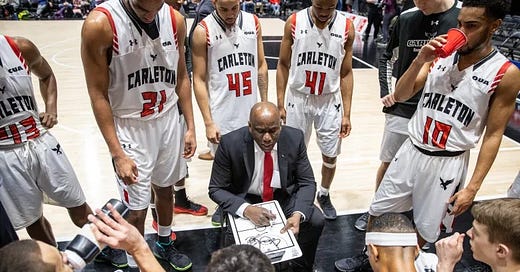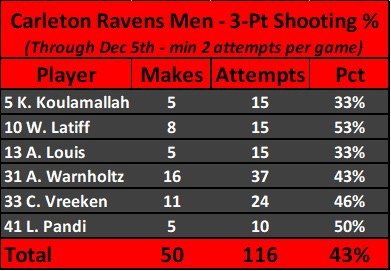A misconception about the more-intensive focus on analytics in basketball is that the nerds with the calculators and spreadsheets think that players should only shoot threes. Three is worth 50 percent more than two, you fools, so as many shots as possible should be from behind the arc.
So far this season, U SPORTS Men’s Basketball teams have attempted 8358 three-pointers in regular season games, hitting 2574 of them. That’s 30.8 percent. And on average about 37.5 percent of field goal attempts have been three-pointers.
What that means is that in an average U SPORTS game, out of every 100 field goal attempts, 38 have been from the land beyond, and 11 or 12 are converted. The nerds should be happy.
Wait, who is that rapping at my chamber door?
The most accurate team from the land beyond are the Carleton Ravens (surprise, surprise), shooting 43% from behind the long-line. They are a full three percentage points ahead of the number-two team on the list, the Brock Badgers.
Strangely, they are ranked second-to-last in three-point attempt frequency (30%), ahead of only Algoma. No really, take a look:
We are chalk in the middle of the Sprawlball era of basketball. And the best team in the nation, boasting the most efficient offense (123.0 ORtg) yet again (it’s early, but still), is by far the best three-point shooting team in the country. Yet, in comparison to their U SPORTS brethren, most of their shots are being taken from inside the arc. Why? Why don’t they shoot more threes? They’re good at it! What in the Nylon Calculus is going on here?
Attacking the Rack
Back to the aforementioned misconception (say that three times fast). There are two other types of shot that are more efficient than threes: shots at the rim and free-throws. And Carleton gets a ton of both.
According to Synergy Sports tracking data, Carleton ranks in the 80th percentile or higher in all the “near the rim” stats they keep count of. Combine that efficiency with their strong offensive rebounding (5th in OReb %) and their aggressive rim attacks helping them get to the line a ton (2nd in free-throw rate), their focus on the interior makes sense.
A look at any game film shows that a major part of Carleton’s offensive philosophy is to find the mismatch, spread the floor, and exploit it via a one-on-one or pick-and-roll attack. Because of their talent and disciplined spacing, this inevitably leads to difficult help rotations for the defense. Seams are created everywhere, usually leading to fouling or overhelping by the defense.
Since Carleton can generate this sort of rim pressure on a consistent basis, it makes sense that it is their primary mode of attack.
But when the defense does rotate and collapse into the paint effectively, cutting off the first option, it leads to kickouts for three.
Quality over Quantity
When it comes to feasting from three, Carleton are picky eaters. Our analytics team here at Game of Runs headquarters watched and charted every regular season three-point attempt – 124 in all, per Synergy’s tracking – the Ravens have taken in their six games thus far.
(Let me get on my soapbox for a second)
The most efficient three-point attempt is when the shooter is
Open
Doesn’t have to do a whole lot before getting into their shot motion and
Knows how to shoot that damn thing
What this means is that, in my opinion, the open inside-out three – meaning the ball was inside the arc, usually as deep as the paint, and was passed out to a shooter – is the most efficient three-point shot attempt in basketball. Think about it. The shooter is already square on the catch and assuming the pass is decent they simply have to rise and fire. Every other type of attempt from Wardell World – off a swing pass, off the bounce, etc – involves a bunch of movement, and footwork, and “stuff” that’s needed to be taken care of before a shooter can even think about setting their feet and squaring up for a shot. Catch and shoot attempts from an interior pass take all that junk out of it.
These are what I consider a quality three-point shot. And they are gold to any offense. And Carleton, while they don’t take many, exploits the heck out of them.
(Okay, I’m getting down)
Of their 56 three-point shots charted as “Open” (meaning little or no defensive contest on the release) Carleton has hit 24 (43%), which is about what they are shooting on “contested” shots as well. This seems curious, as you would suspect that open shots would convert at a higher rate than guarded or contested shots.
On shots where passes are coming off of kickouts – meaning inside-out - the percent ticks up to 47% on 64 attempts. Again, good, but not as high as you would suspect in comparison to other pre-shot pass sources given their overall percentage of 43%.
But when you combine the two, filtering for shots that come both after a kickout and that are open, the number is at 55% on 31 attempts.
Now we’re talking.
There are six Carleton players averaging at least two three-point attempts per contest.
So the ones taking the most shots from beyond the arc are doing the job. But check out when you filter for open off of an inside-out pass.
That’s some elite shooting.
To be fair, if I did this exercise with every team, we’d probably see similar jumps in percentages, but I’m willing to wager that Carleton takes and makes a higher percentage of “quality” threes than most other teams in the country. And they do a good job of avoiding “bad” threes.
Assuming the OUA gets going again in the new year at some point, Carleton’s competition was scheduled to be ramping up over the second-half of the season. It will be interesting to see if these shooting trends hold against more staunch defenses.
But one thing is for certain, Carleton will continue to be selective in their three point attempts and searching out only the most quality of looks…and nevermore.








